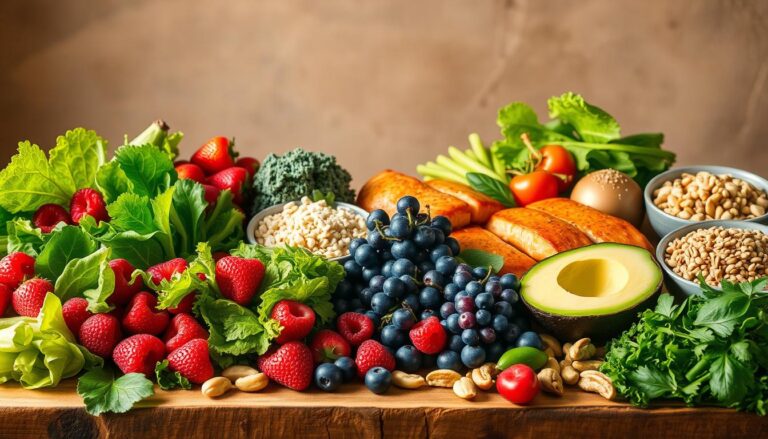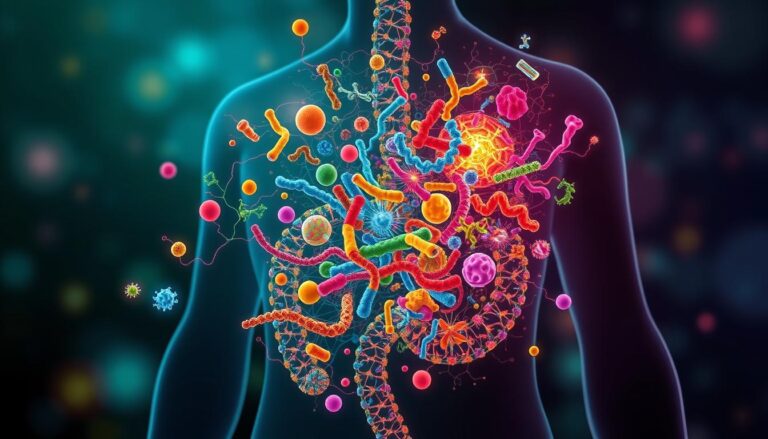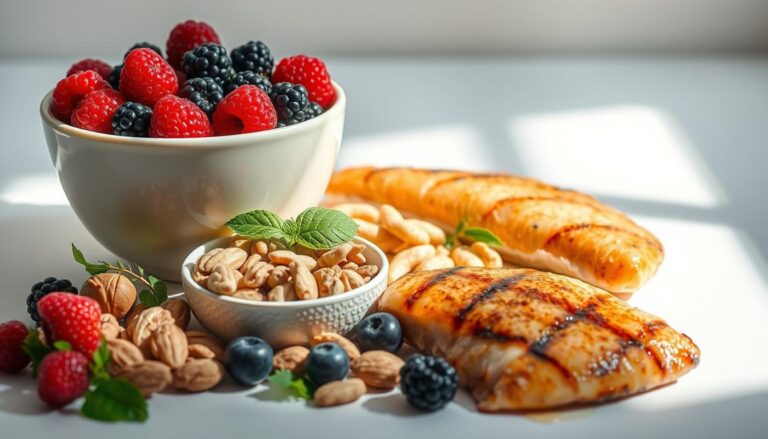As more Americans adopt a plant based diet, the demand for reliable information on protein sources has grown.
According to the International Food Information Council’s 2022 Food and Health Survey 12 percent of Americans now follow a plant-based diet and 31 percent say they’ve been eating more food from whole plant sources.
The variety of novel plant-forward protein sources is expanding rapidly, with new powders milks and meat substitutes emerging every month. But how do these options stack up in terms of nutritional value and environmental impact?
This comprehensive guide will explore the spectrum of plant-based proteins examining their amino acid profiles nutritional completeness, and practical ways to incorporate them into a balanced diet.
Key Takeaways
- Understanding the nutritional value of various plant-based protein sources
- Examining the science behind plant based proteins and their comparison to animal proteins
- Addressing common misconceptions about plant proteins and their health benefits
- Learning how to incorporate plant proteins into a balanced diet
- Navigating the complex world of vegetable proteins for a healthier lifestyle
Understanding Plant Based Protein
Understanding the nuances of plant-based protein is crucial for individuals adopting a vegan or vegetarian lifestyle. Plant based proteins vary significantly in their amino acid composition which is a critical factor in determining their nutritional value.
What Makes a Complete Protein
A complete protein is one that provides all nine essential amino acids that the human body cannot synthesize on its own. Quinoa, buckwheat, hemp seeds, chia seeds, and soy products like tofu and tempeh are examples of complete vegetable protein sources.
Essential Amino Acids Explained
The nine essential amino acids are histidine, isoleucine, leucine, lysine, methionine, phenylalanine, threonine, tryptophan, and valine. As noted by a study A diet that includes a variety of plant-based foods can provide all the necessary amino acids for optimal health.
A well planned plant-based diet can meet protein needs without the need for animal products.
Historically it was believed that plant-based eaters needed to combine proteins at each meal but current research suggests that consuming a variety of plant proteins throughout the day is sufficient.
The Science Behind Plant Based Protein
As more people turn to plant based diets it is essential to examine the science that supports the nutritional adequacy of these proteins. Research has shown that plant proteins can be just as effective as animal proteins in meeting human nutritional needs.
Understanding how plant proteins compare to animal proteins is crucial. While animal proteins typically contain all essential amino acids in one food, plant proteins often have different amino acid profiles.
How Plant Proteins Compare to Animal Proteins
Studies have demonstrated that plant proteins, when consumed in adequate amounts and variety, can provide all necessary amino acids. The main difference lies in their amino acid composition and digestibility.
Debunking the Incomplete Protein Myth
Recent research including a 2019 study on vegan and vegetarian diets has debunked the myth that plant proteins are incomplete. The study found that these diets provided more-than-adequate protein and amino acids.
| Protein Source | Amino Acid Profile | Digestibility |
|---|---|---|
| Animal Protein | Complete amino acid profile | High |
| Plant Protein | Varies by type | Generally lower, but can be optimized |
Health Benefits of Plant Based Proteins
A diet rich in plant-based proteins is associated with various health benefits. Studies have shown that plant based diets can lead to healthy weight maintenance, lower risk of type 2 diabetes, and even longer life.

Weight Management and Disease Prevention
Plant-based proteins offer numerous advantages, including lower saturated fat content and zero cholesterol compared to most animal proteins. Research indicates that diets rich in plant proteins are associated with reduced risk of cardiovascular disease certain cancers, and type 2 diabetes, thus aiding in disease prevention and weight management.
Fiber and Nutrient Advantages
The fiber naturally present in many plant protein sources supports digestive health, promotes satiety, and helps regulate blood sugar levels. Additionally, plant proteins come with beneficial phytonutrients antioxidants, and nutrients that support overall health and immune function, making them a valuable part of a balanced diet for the body.
Potential Drawbacks of Plant Based Proteins
As the demand for plant-based proteins grows, it’s crucial to examine their potential drawbacks. While generally considered healthy, a plant-based diet can have some limitations.
Vitamin B12 Considerations
One significant concern is the lack of vitamin B12 in plant-based foods, which is essential for brain function and red blood cell formation. Unless fortified, plant foods are virtually devoid of this vitamin, making supplementation necessary for those on a strict plant-based diet.
Highly Processed Plant Proteins
Some plant-based protein foods, such as plant-based meats and cheeses, are highly processed. This processing can result in products containing excessive sodium oils, and additives, potentially diminishing their nutritional value and impacting overall health.
The Best Vegetable Protein Sources
Exploring the world of vegetable proteins reveals a diverse array of nutritious and sustainable options. These protein sources are not only beneficial for health but also offer environmental advantages.
Lentils The Protein Powerhouse
Lentils stand out as one of the most protein-dense plant foods, offering approximately 18 grams of protein per cooked cup. They are also rich in iron, folate, and fiber making them a nutritious addition to various meals.
Quinoa The Complete Protein Grain
Quinoa is a complete protein, containing all nine essential amino acids. It provides about 8 grams of protein per cup and is high in fiber, magnesium, and antioxidants, making it a versatile and nutritious choice.
Chickpeas and Other Legumes
Chickpeas, black beans, kidney beans, and pinto beans are high in protein 7-15 grams per cup and rich in resistant starch supporting gut health. These legumes are not only nutritious but also versatile in various cuisines.
These top vegetable protein sources are both nutritionally superior and environmentally sustainable, requiring less water and producing fewer greenhouse gas emissions than animal proteins. Incorporating them into your diet can be easy and delicious, with a wide range of culinary options available.
Nutritional Superstars Seeds and Nuts
Among the most nutritious options for plant-based protein are seeds and nuts. These foods not only provide a significant amount of protein but also offer a range of other essential nutrients.
Hemp Seeds
Hemp seeds are a complete protein source, containing all nine essential amino acids. They are rich in omega-3 fatty acids, supporting heart and brain health. With about 10 grams of protein per 3 tablespoons, hemp seeds are a versatile addition to smoothies, salads, and baked goods.
Nuts and Nut Butters
Nuts are another excellent choice for plant-based protein, offering convenience and versatility. For instance, pistachios provide 6 grams of protein per quarter cup serving. Various nuts offer unique nutrient profiles: almonds are rich in calcium walnuts in omega-3s, and Brazil nuts in selenium. Nut butters like almond butter and tahini are also concentrated protein sources that can be easily incorporated into meals.
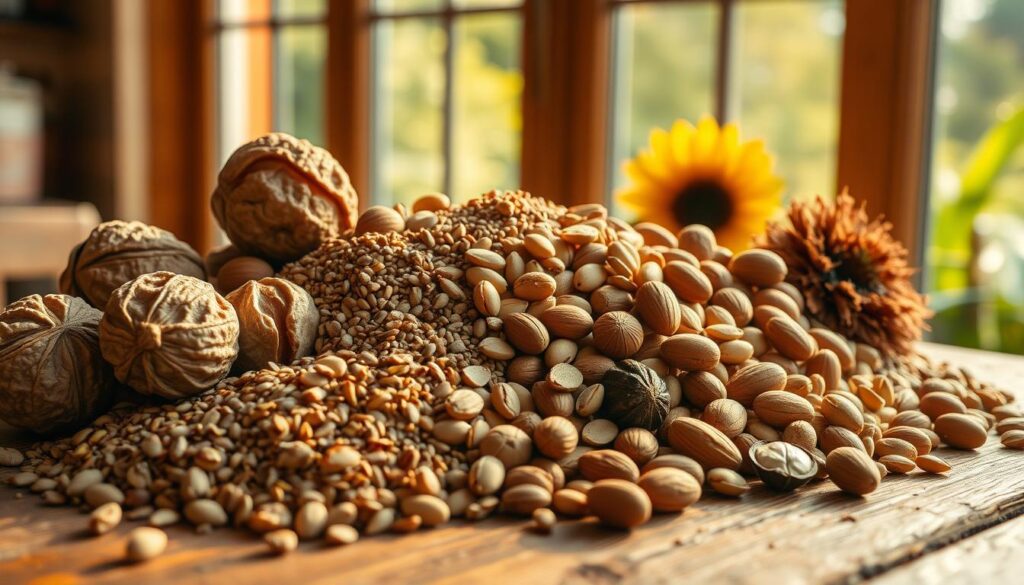
Soy Based Proteins
Among the various plant-based protein sources, soy-based proteins are particularly noteworthy for their health benefits. Soy foods have been shown to offer numerous nutritional advantages, making them a valuable component of a balanced diet.
Tofu and Tempeh
Tofu made from condensed soy milk, is a versatile protein source available in various textures, including silken, soft, firm, and extra firm. It contains approximately 8-15 grams of protein per 3-ounce serving. Tempeh created from fermented soybeans, has a firmer texture and nuttier flavor than tofu, with a higher protein content of about 15-20 grams per 3-ounce serving.
Edamame and Soy Milk
Edamame, or immature soybeans, delivers approximately 17 grams of protein per cup, along with fiber and micronutrients, making it an excellent whole food soy option. Soy milk and other soy products, such as yogurt alternatives, offer convenient ways to incorporate soy protein into the diet, with fortified versions providing calcium and vitamin D comparable to dairy products.
| Soy Product | Protein Content | Serving Size |
|---|---|---|
| Tofu extra-firm | 10.6g | 3.5 oz |
| Edamame | 9.2g | ½ cup |
| Tempeh | 15-20g | 3 oz |
A 2020 study found that consuming soy foods reduced the risk of breast cancer in over 300,000 women. The American Cancer Society supports the safety and health benefits of soy foods, citing their potential protective effects against certain cancers and heart disease.
Vegetable Protein The Best the Worst and Everything In Between
Understanding the protein content in various plant-based foods is crucial for making informed dietary choices. Different plant-based proteins offer varying amounts of protein per serving, which can significantly impact their effectiveness in meeting nutritional needs.
Comparing Protein Content per Serving
The protein content per serving among plant-based proteins varies widely. For instance, vital wheat gluten seitan provides an impressive 21 grams of protein per ¼ cup, while oats offer a more modest 5.3 grams per ½ cup.
| Plant-Based Protein Source | Serving Size | Protein Content grams |
|---|---|---|
| Vital Wheat Gluten Seitan | ¼ cup | 21 |
| Pea Protein Powder | 1 scoop 22g | 19 |
| Lentils | ½ cup | 9 |
| Edamame | ½ cup | 9.2 |
| Oats | ½ cup | 5.3 |
Bioavailability Factors
Bioavailability or how efficiently the body can utilize protein, differs among plant sources. Soy protein has a high PDCAAS score of 0.9-1.0, comparable to animal proteins. Factors such as amino acid profile digestibility, and the presence of antinutrients affect bioavailability.
Processing methods like fermentation and sprouting can improve protein absorption. Understanding both protein content and bioavailability helps consumers make informed choices about their plant-based protein intake.
The Worst Vegetable Protein Sources
Not all vegetable proteins are created equal, and some may fall short in terms of nutritional value. While plant-based proteins are generally considered healthy, certain sources have significant drawbacks that consumers should be aware of.
Rice Protein Limitations
Rice protein, often used in plant-based protein blends, has notable limitations as a standalone protein source. It is low in the essential amino acid lysine, making it an incomplete protein source. Additionally, rice protein may contain high levels of arsenic, a contaminant that can accumulate in rice over time.
Corn Protein Drawbacks
Corn protein is another example of a less desirable plant protein source due to its incomplete amino acid profile. It lacks adequate amounts of lysine and tryptophan, essential amino acids vital for various bodily functions. Moreover, corn protein tends to be low in other nutrients, reducing its overall nutritional value.
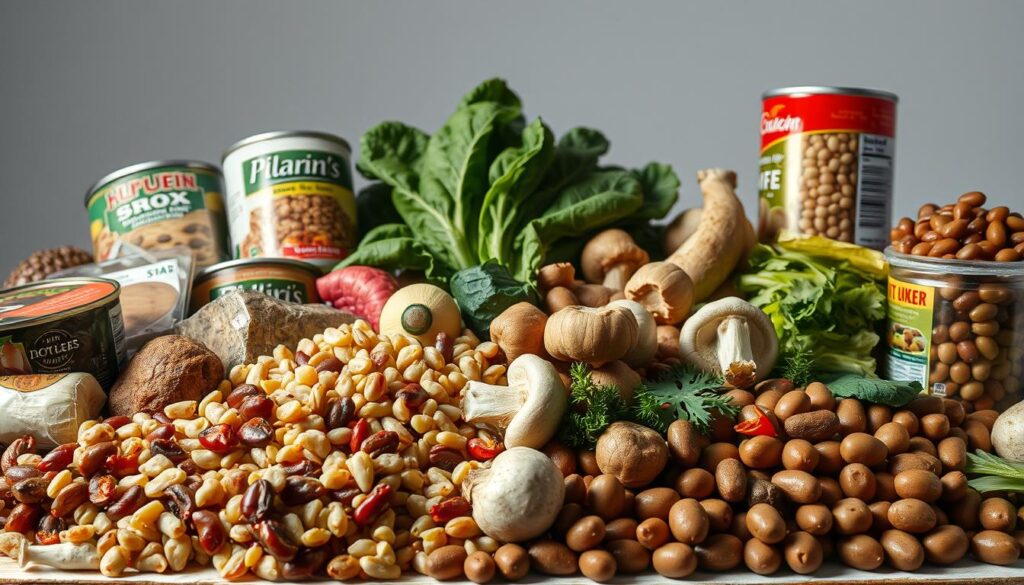
- Rice protein is limited by its low lysine content and potential arsenic contamination.
- Corn protein has an incomplete amino acid profile and lacks essential nutrients.
- Both rice and corn proteins have lower biological values and protein density compared to other plant proteins.
Middle Ground Plant Proteins
As we explore the world of plant-based proteins, we find that some proteins, like pea protein and seitan, offer a mix of advantages and drawbacks. These middle-ground proteins are neither the best nor the worst instead, they provide a balance that can be beneficial in certain contexts.
Pea Protein Benefits and Limitations
Pea protein is considered an excellent plant-based protein due to its solid amino acid profile, although it is slightly low in methionine. It is hypoallergenic and easy to digest, making it a popular choice for protein powders. When combined with other plant proteins like rice or hemp, pea protein can provide a complete protein profile.
Wheat Gluten Seitan
Seitan, made from vital wheat gluten, is a protein-dense food, containing 21g of protein per quarter cup. It is a good source of protein for those who can tolerate gluten. However, it is not suitable for individuals with celiac disease or gluten sensitivity, which is a significant limitation.
Here is a comparison table between pea protein and seitan:
| Protein | Protein Content | Main Limitation |
|---|---|---|
| Pea Protein | High | Low in methionine |
| Seitan Wheat Gluten | Very High | Contains gluten |
Environmental Impact of Plant Proteins
Understanding the environmental footprint of plant proteins is crucial for making informed dietary choices. As the global population continues to grow, the demand for protein sources that are both sustainable and environmentally friendly has become a pressing issue.
Research has shown that shifting from an omnivore diet to a plant-based diet can significantly reduce greenhouse gas emissions. A 2019 study found that adopting a vegan diet reduced personal greenhouse gas emissions by 50 percent, while a lacto ovo vegetarian diet brought them down by 35 percent.
Carbon Footprint Comparison
Plant proteins generally have significantly lower carbon footprints than animal proteins. For example, beef produces approximately 50kg CO2-equivalent per 100g protein, whereas lentils produce less than 1kg CO2-equivalent per 100g protein. This stark contrast highlights the potential environmental benefits of choosing plant-based proteins.
| Protein Source | CO2-Equivalent kg per 100g protein |
|---|---|
| Beef | 50 |
| Lentils | <1 |
| Chickpeas | 1.5 |
Water Usage and Land Requirements
The water usage for plant protein production is substantially lower than for meat. Producing 1kg of beef requires approximately 15,000 liters of water, whereas producing 1kg of pulses requires only about 4,000 liters. Additionally, land efficiency strongly favors plant proteins, with animal agriculture occupying approximately 77% of global agricultural land while providing only 33% of global protein supply.
The water footprint of beef, for example, is six times higher than that of pulses according to data from the Water Footprint Network.
Some plant proteins, like rice and nuts (particularly almonds), have higher water footprints. However, choosing environmentally efficient plant proteins like legumes and certain grains can significantly reduce one’s ecological footprint while meeting nutritional needs.
Plant Protein Powders and Supplements
In the realm of nutritional supplements, plant-based protein powders are gaining significant attention. As consumers look for plant-based proteins that align with their dietary preferences, understanding the nuances of these protein powders becomes essential.
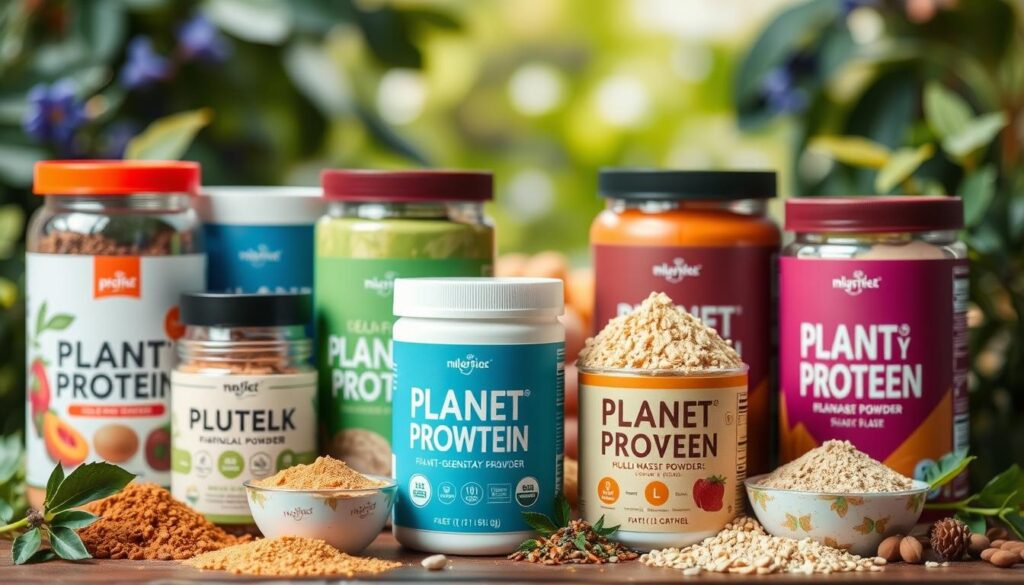
Single-Source vs. Blended Formulas
Single-source plant protein powders, like pea or rice protein, have distinct nutritional profiles. For instance, pea protein is rich in lysine but low in methionine, while rice protein has the opposite profile. Blended formulas, on the other hand, combine different sources to create a complete amino acid profile, making them a more balanced source of protein.
What to Look for on Labels
When choosing a plant-based protein powder, consumers should examine the label for protein content per serving ideally over 20 grams protein , the completeness of the amino acid profile, and the presence of any additional ingredients or sweeteners. Checking for third-party testing certifications can also ensure the quality and purity of the product, providing various options to meet different needs and levels of fitness goals.
Addressing Common Concerns About Plant Proteins
As we dive into the world of plant-based proteins, it’s essential to address some common concerns that have been associated with their consumption. For instance, the impact of soy on health has been a topic of debate.
Soy and Hormonal Effects Myths vs Facts
Research has clarified that moderate soy consumption does not negatively affect hormone levels in men or women. In fact, a 2020 study involving over 300,000 women showed that eating soy foods reduced their chances of developing breast cancer. The health benefits of soy are supported by the American Cancer Society, which contends that soy foods are both healthy and safe.
Managing Food Allergies and Sensitivities
For individuals with food allergies or sensitivities, there are numerous plant protein alternatives available. Those with soy allergies can opt for legumes, seeds, and grains. Understanding the difference between food allergies and sensitivities is crucial for identifying which plant proteins work best for individual health needs.
| Protein Source | Allergy/Sensitivity | Alternative |
|---|---|---|
| Soy | Allergy | Legumes, seeds, grains |
| Legumes | Sensitivity | Seeds, grains, pseudograins |
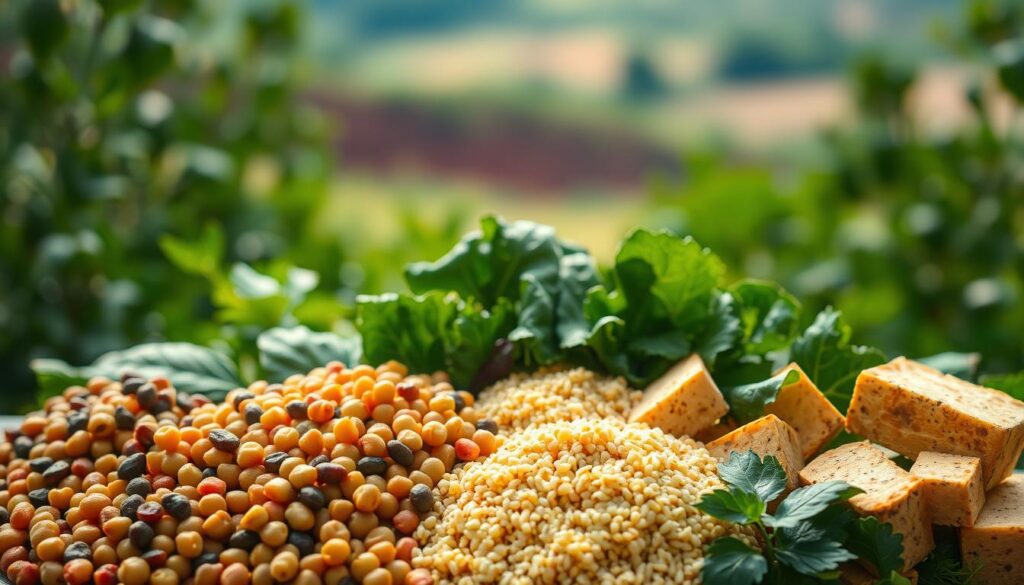
Incorporating More Plant Proteins Into Your Diet
Eating a diet rich in plant proteins can be achieved by making a few key changes to your meal routine. This can involve starting your day with high protein breakfasts like chocolate banana breakfast quinoa or a tofu scramble.
Simple Meal Ideas
Some simple meal ideas include barbecue chickpea wraps or simple broccoli-peanut noodles for lunch, and black bean and spinach enchilada casserole or a veggie-packed lentil soup for dinner. These meals are not only high in protein but also flavorful and easy to prepare.
Gradual Transition Tips
When transitioning to a more plant-based diet, start with familiar foods and gradually incorporate plant proteins. For example, add lentils to soups, chickpeas to salads, or tofu to stir-fries. This gradual approach makes the transition more sustainable.
Here is a table showing some high-protein plant-based foods:
| Food | Protein Content | Serving Size |
|---|---|---|
| Lentils | 18g | 1 cup cooked |
| Chickpeas | 15g | 1 cup cooked |
| Tofu | 20g | 3 oz serving |
Balancing Your Plant Protein Intake
Balancing plant protein intake is essential to meet the body’s protein needs. A well balanced diet is likely to supply sufficient amounts of all 20 amino acids, both essential and non essential, as supported by a 2019 study on people following vegan and vegetarian diets.
Creating Complementary Protein Combinations is crucial for optimal amino acid intake. While strict protein combining at each meal is unnecessary, creating naturally complementary protein combinations throughout the day ensures that the body gets all the necessary amino acids. Examples include beans with rice, hummus with whole grain pita, or peanut butter on whole grain bread.
Creating Complementary Protein Combinations
Examples of complementary protein combinations include legumes with grains or nuts with whole grains. These combinations ensure that all essential amino acids are consumed over the course of the day.
Daily Protein Requirements on a Plant Based Diet
Daily protein requirements on a plant-based diet are generally similar to those on conventional diets, ranging from 0.8 to 1.0 grams per kilogram of body weight for average adults. However, some experts suggest a slight increase to 1.0-1.2 grams per kilogram to account for potentially lower digestibility. Active individuals and athletes may require higher protein intakes, typically between 1.2-2.0 grams per kilogram.
Conclusion
Having examined the various aspects of plant-based proteins, it is clear that they play a crucial role in maintaining a healthy diet and promoting environmental sustainability.
The landscape of vegetable proteins offers tremendous variety, from nutritional powerhouses like lentils and hemp seeds to less optimal choices like isolated corn and rice proteins.
Scientific evidence supports the adequacy of well-planned plant-based diets for meeting protein needs across all life stages.
Moreover, plant-based proteins offer additional health benefits through their fiber content, phytonutrients, and favorable fatty acid profiles, making them a valuable component of a healthy diet that supports both personal health and planetary wellbeing.

